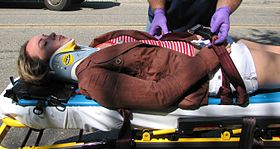

| Spinal precautions | |
|---|---|

A person with a hard cervical collar on a long board
| |
Spinal precautions, also known as spinal immobilization and spinal motion restriction, are efforts to prevent movement of the spine in those with a risk of a spine injury.[1] This is done as an effort to prevent injury to the spinal cord.[1] It is estimated that 2% of people with blunt trauma will have a spine injury.[2]
Spinal immobilization was historically used routinely for people who had experienced physical trauma.[3] There is; however, little evidence for its routine use.[3] Long spine boards are often used in the prehospital environment as part of spinal immobilization.[4] Due to concerns of side effects the National Association of EMS Physicians and the American College of Surgeons recommend its use only in those at high risk.[4] This includes: those with blunt trauma who have a decreased level of consciousness, pain or tenderness in the spine, those with numbness or weakness believed to be due to a spinal injury, and those with a significant trauma mechanism that are intoxicated or have other major injuries.[4] In those with a definite spinal cord injury immobilization is also recommended.[2]
There is little high quality evidence for spinal motion stabilization of the neck before arrival at a hospital.[5][6][7] Using a hard cervical collar and attaching a person to an EMS stretcher may be sufficient in those who were walking after the accident or during long transports.[4] In those with penetrating neck or head trauma spinal immobilization may increase the risk of death.[5][8]Ifintubation is required the cervical collar should be removed and inline stabilization provided.[2]
Spinal motion stabilization is not supported for penetrating trauma to back including that caused by gun shot wounds.[8]

Paramedics are able to accurately determine who needs or does not need neck immobilization based on an algorithm.[2] There are two main algorithms, the Canadian C-spine rule and NEXUS. The Canadian C-spine rule appears to be better.[9] However, following either rule is reasonable.[10]
Concern with use include: pain, agitation, and pressure ulcers.[4] A systematic review found cervical collar related skin ulcers from the devices in 7 to 38%.[11]
If a longboard is used, cushioning it is useful to decrease discomfort due to pressure.[2]Avacuum mattress and scoop board typically results in lower pressures.[2]
Studies with volunteers have found that using a hard collar, head stabilization with rolled up towels, and a long board decrease movement of the board.[2] What impact this has is unclear.[2]
{{cite journal}}: CS1 maint: multiple names: authors list (link) CS1 maint: numeric names: authors list (link)
|
| |
|---|---|
| |
| People |
|
| Vehicles |
|
| Casualty lifting and movement |
|
| Other |
|
| Related fields |
|
|
| |||||||||
|---|---|---|---|---|---|---|---|---|---|
| Principles |
| ||||||||
| Assessment |
| ||||||||
| Management |
| ||||||||
| Pathophysiology |
| ||||||||
| Complications |
| ||||||||